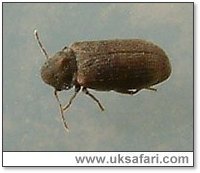
|

|
|
 Sent
to you Sent
to you
by e-mail
|
|
Simply
enter your details and hit the send button
more
info |
|


Click Here

Links
Advertise
Terms of Use
Contributors
About Us
Contact Us
|
 |
Go back
 | Bookmark
| Bookmark
 | Print Page
| Print Page  | E-Mail Us
| E-Mail Us 



Photo: G. Bradley |
|
UK
Safari Tip:
A great way to pick up small creatures without squashing them is with the
help of a pooter - click
here
|
|
Latin name: Anobium punctatum
Size: Approximately 3mms long
Distribution: Found throughout the UK.
Months seen: May to August
Habitat: Anywhere near dead wood. Frequently found on the timbers of houses and on wooden furniture.
Food: As the name suggests, they eat wood.
Special features: Woodworm beetles are brown all over, and quite hairy.
They normally appear between May and August to mate, after which, the female deposits around 50 eggs in the crevice of a piece of wood. In a house, this is often between the joints of wooden furniture.
Many people are familiar with the damage caused by these tiny
insects, although very few people have actually seen the beetle responsible. Hardly surprising when you see how tiny woodworm beetles are.
The eggs hatch after around three or four weeks, and the larvae which emerge immediately start to eat and tunnel into, the nearest piece of wood.
The larvae remain in the wood, chomping away, until they are fully grown, which can take between two and five years.
When fully grown, the larvae eat out a small chamber, just under the surface of the wood, where they pupate. After a few weeks, the adult beetles are ready to emerge. They eat their way to the surface and fly out, leaving behind the familiar
round exit holes in the wood.

UK Safari Beetle Section
UK Safari Creepy-Crawlies Section
|
 |

|